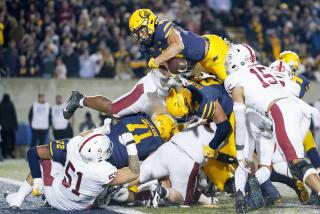If Pacific Exchange Merges, Trading Floors May Go
- Share via
San Francisco and Los Angeles have housed vibrant stock exchange floors since the 19th century, but they may not make it into the 21st.
When board members of the Pacific Exchange meet in Carmel on Tuesday, they are expected to discuss whether a possible merger with the Chicago Board Options Exchange could mean spinning off the Pacific’s equity business and closing its two stock trading floors, those familiar with the talks said.
While details of the merger negotiations, confirmed by the CBOE and the Pacific on Monday, have yet to be revealed, many traders believe the CBOE is interested in acquiring only the Pacific’s lucrative and booming business of trading stock option contracts, and not its slower-growing stock trading operation.
If that happens, the stock exchange--which, like the handful of other regional U.S. exchanges, offers institutional and individual investors a competing market to the New York Stock Exchange--may have to join with another market or a technology company to survive. Recent discussions have been held with the Nasdaq Stock Market--and with America Online, sources said.
Although the Pacific traded a relatively modest 3.3 billion shares last year, which was just 1.9% of total trading in NYSE-listed shares, many clients and brokers believe it serves an important purpose.
“We want the equity business to survive,” said David Herron, manager of equity trading floor operations for brokerage Charles Schwab, which has 14 Pacific “specialist” seats--the individual traders who stand ready to buy stocks from or sell them to investors, thus creating an orderly market, or exchange.
“We want to support them any way we can. With this [possible] merger, it would be awfully easy to forget the equity business, but we like the low cost and customer service it provides.”
Robert M. Greber, chairman of the Pacific, said there’s been “a lot of unnecessary angst” about the fate of the equity trading operation, which in Los Angeles employs a staff of about 100, plus about 50 specialists.
“All parties should be aware that the equity business is a strong component of the Pacific Exchange,” he said. “We are not asleep. But I don’t think that equity trading needs a physical exchange.”
Indeed, the 116-year-old Pacific--which traces its roots back to the Gold Rush--conceivably could become a “virtual” stock exchange, without a trading floor.
While some traders, like Herron, said they like the business environment that traditional exchanges provide, other traders said closure of the floors is the most likely scenario given that leases on both the San Francisco and downtown Los Angeles trading floors will be up in the next few years--and that most securities markets are seeking to slash operating expenses to reduce trading costs for investors.
What’s more, the Pacific--which splits stock trading about 50-50 between its San Francisco and Los Angeles floors--has been considering moving its specialist posts into member brokerages’ own offices.
The Cincinnati Stock Exchange already operates as a floorless exchange with specialist posts located in its member firms’ offices. It’s a hybrid exchange, blending elements of the NYSE specialist system and the all-electronic Nasdaq market.
The Cincinnati Stock Exchange isn’t even in Cincinnati; its 35-person staff is in Chicago and its chairman in New York.
Traders say the Pacific’s stock operations could be a good fit with the Cincinnati, which traded 1.2% of all NYSE share volume in 1997.
“Critical mass is important. We are willing to talk to anybody,” said David Colker, the Cincinnati exchange’s president. He said his exchange has had informal discussions with the Pacific.
The Nasdaq market, too, might want the Pacific. The Nasdaq, where stock trades are negotiated electronically among dealers nationwide--as opposed to being handled by a single specialist gatekeeper for each stock--is diversifying by acquiring the American Stock Exchange, which, like, the NYSE and Pacific is a specialist-operated system.
“We’d be very interested,” said Alfred Berkeley, president of the Nasdaq Stock Market. “We’d like to have a presence on the West Coast, and they’ve been very advanced in terms of electronics.”
There are other, more unusual alliances possible, such as with America Online.
“I would expect they could partner with an Internet or software company,” said Gary Wedbush, trading chief for Wedbush Morgan Securities in Los Angeles, which has seven seats on the exchange.
The wild card in any merger, say traders, is a new all-electronic trading system devised by OptiMark Technologies of Durango, Colo., and set to start up in September. It is designed to allow big investors to trade directly with one another, via the Pacific’s system, and be assured anonymity.
“No one should discount the value of OptiMark. We’re not dealing from weakness. We consider that a big plus,” Greber said.
Bill Lupien, chairman of OptiMark, said he would be supportive of any partnership that shifted the Pacific’s equity operations from a physical floor to an electronic system, although he worked on the Los Angeles trading floor for 17 years.
“I’m torn. I have mixed feelings. The floor is a tremendous business and social environment,” he said. “But with an electronic exchange, you drive costs down and you expand your market.”
While a merger between the Pacific and the CBOE is by no means a done deal, some type of alliance is likely for the Pacific, and soon, many analysts say, as securities markets in general consolidate at a rapid pace.
Most regional U.S. exchanges are scrambling to find partners that can help them reach the critical mass needed to provide more liquid markets for investors seeking to buy or sell, and to offset the cost of maintaining the expensive technology needed to operate.
The Pacific and other regional exchanges, once designed mainly for local stocks, now trade many of the same stocks as the NYSE. Some brokers find the regional exchanges attractive because they keep the NYSE from establishing a monopoly over trading and thus ensure competitive pricing.
But as the NYSE has become a huge international marketplace, the smaller exchanges have carved out new niches.
Trading of put and call options--low-cost contracts that allow investors to bet on whether a stock price will go up or down--has become the bread and butter of the Pacific. It’s now the third-largest trader of options and the fastest-growing options exchange. CBOE is the largest.
The Pacific traded 46.7 million option contracts in 1997, up 185% over 1993’s volume.
The Pacific dates to 1882, with the creation of the San Francisco Stock and Bond Exchange. In 1899, the Los Angeles Oil Exchange was formed. The two merged in 1956.
*
Debora Vrana can be reached by e-mail at debora.vrana@latimes.com.
More to Read
Inside the business of entertainment
The Wide Shot brings you news, analysis and insights on everything from streaming wars to production — and what it all means for the future.
You may occasionally receive promotional content from the Los Angeles Times.










